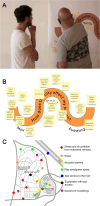Citizen science and social innovation as citizen empowerment tools to address urban health challenges: The case of the urban health citizen laboratory in Barcelona, Spain
- PMID: 38478480
- PMCID: PMC10936789
- DOI: 10.1371/journal.pone.0298749
Citizen science and social innovation as citizen empowerment tools to address urban health challenges: The case of the urban health citizen laboratory in Barcelona, Spain
Abstract
Urban health faces significant challenges due to the rapid growth of cities and the concentration of population in urban settings that have a strong impact on people's health. The approach to characterize and address these challenges requires increased societal involvement and interdisciplinary solutions to ensure their effectiveness and democratic nature. With this purpose, it is necessary to explore methodologies for citizen participation that foster a critical understanding of the environment and promote their active role in generating scientific knowledge and change. This article describes the creation of a collaborative space for experimentation and learning that, through the intersection of citizen science and social innovation, aims to engage citizens in the research and diagnosis of their local environment, as well as in the design and implementation of local solutions, while raising awareness about the main challenges to urban health. Through a collaborative and participatory framework, the community identified relevant challenges to urban health they wanted to investigate, co-designed and developed the methodology for data collection and analysis, and ultimately, they devised, designed, and implemented innovative solutions based on the scientific evidence obtained. The framework and results of this project hold potential interest for the scientific community, facilities, institutions, and society by offering an innovative and participatory approach to addressing the present and future urban health challenges.
Copyright: © 2024 Santos-Tapia et al. This is an open access article distributed under the terms of the Creative Commons Attribution License, which permits unrestricted use, distribution, and reproduction in any medium, provided the original author and source are credited.
Conflict of interest statement
The authors have declared that no competing interests exist.
Figures




Similar articles
-
Co-creating a local environmental epidemiology study: the case of citizen science for investigating air pollution and related health risks in Barcelona, Spain.Environ Health. 2022 Jan 12;21(1):11. doi: 10.1186/s12940-021-00826-8. Environ Health. 2022. PMID: 35022033 Free PMC article.
-
Fostering citizen-engaged HIV implementation science.J Int AIDS Soc. 2024 Jul;27 Suppl 1(Suppl 1):e26278. doi: 10.1002/jia2.26278. J Int AIDS Soc. 2024. PMID: 38965981 Free PMC article.
-
Citizen involvement in research on technological innovations for health, care or well-being: a scoping review.Health Res Policy Syst. 2024 Sep 2;22(1):119. doi: 10.1186/s12961-024-01152-4. Health Res Policy Syst. 2024. PMID: 39223606 Free PMC article.
-
Implementing co-created citizen science in five environmental epidemiological studies in the CitieS-Health project.Environ Res. 2024 Jan 1;240(Pt 2):117469. doi: 10.1016/j.envres.2023.117469. Epub 2023 Oct 21. Environ Res. 2024. PMID: 37871787
-
A call for citizen science in pandemic preparedness and response: beyond data collection.BMJ Glob Health. 2022 Jun;7(6):e009389. doi: 10.1136/bmjgh-2022-009389. BMJ Glob Health. 2022. PMID: 35760438 Free PMC article. Review.
References
-
- Department of Economic and Social Affairs Population Division. World Urbanization Prospects The 2014 Revision.
-
- Ompad DC, Galea S, Vlahov D. Urban Health Systems: Overview. International Encyclopedia of Public Health 2017; 311–317.
-
- Koch S, Khomenko S, Cirach M, et al.. Impacts of changes in environmental exposures and health behaviours due to the COVID-19 pandemic on cardiovascular and mental health: A comparison of Barcelona, Vienna, and Stockholm. Environmental Pollution; 304. Epub ahead of print 1 July 2022. doi: 10.1016/j.envpol.2022.119124 - DOI - PMC - PubMed
MeSH terms
LinkOut - more resources
Full Text Sources

